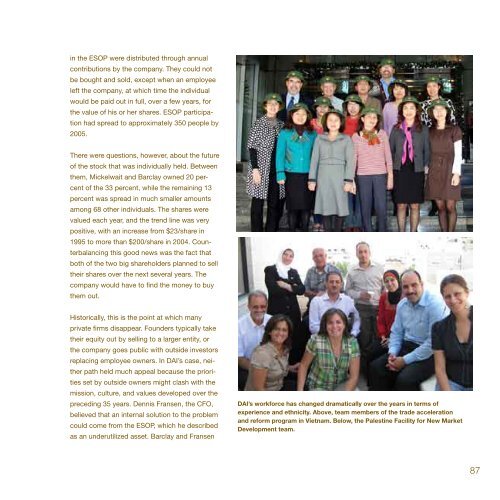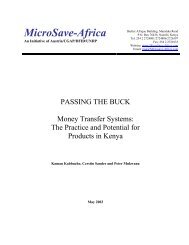You also want an ePaper? Increase the reach of your titles
YUMPU automatically turns print PDFs into web optimized ePapers that Google loves.
in the ESOP were distributed through annual<br />
contributions by the company. They could not<br />
be bought and sold, except when an employee<br />
left the company, at which time the individual<br />
would be paid out in full, over a few <strong>years</strong>, for<br />
the value <strong>of</strong> his or her shares. ESOP participation<br />
had spread to approximately 350 people by<br />
2005.<br />
There were questions, however, about the future<br />
<strong>of</strong> the stock that was individually held. Between<br />
them, Mickelwait and Barclay owned 20 percent<br />
<strong>of</strong> the 33 percent, while the remaining 13<br />
percent was spread in much smaller amounts<br />
among 68 other individuals. The shares were<br />
valued each year, and the trend line was very<br />
positive, with an increase from $23/share in<br />
1995 to more than $200/share in 2004. Counterbalancing<br />
this good news was the fact that<br />
both <strong>of</strong> the two big shareholders planned to sell<br />
their shares over the next several <strong>years</strong>. The<br />
company would have to find the money to buy<br />
them out.<br />
Historically, this is the point at which many<br />
private firms disappear. Founders typically take<br />
their equity out by selling to a larger entity, or<br />
the company goes public with outside investors<br />
replacing employee owners. In <strong>DAI</strong>’s case, neither<br />
path held much appeal because the priorities<br />
set by outside owners might clash with the<br />
mission, culture, and values developed over the<br />
preceding 35 <strong>years</strong>. Dennis Fransen, the CFO,<br />
believed that an internal solution to the problem<br />
could come from the ESOP, which he described<br />
as an underutilized asset. Barclay and Fransen<br />
<strong>DAI</strong>’s workforce has changed dramatically over the <strong>years</strong> in terms <strong>of</strong><br />
experience and ethnicity. Above, team members <strong>of</strong> the trade acceleration<br />
and reform program in Vietnam. Below, the Palestine Facility for New Market<br />
Development team.<br />
87



